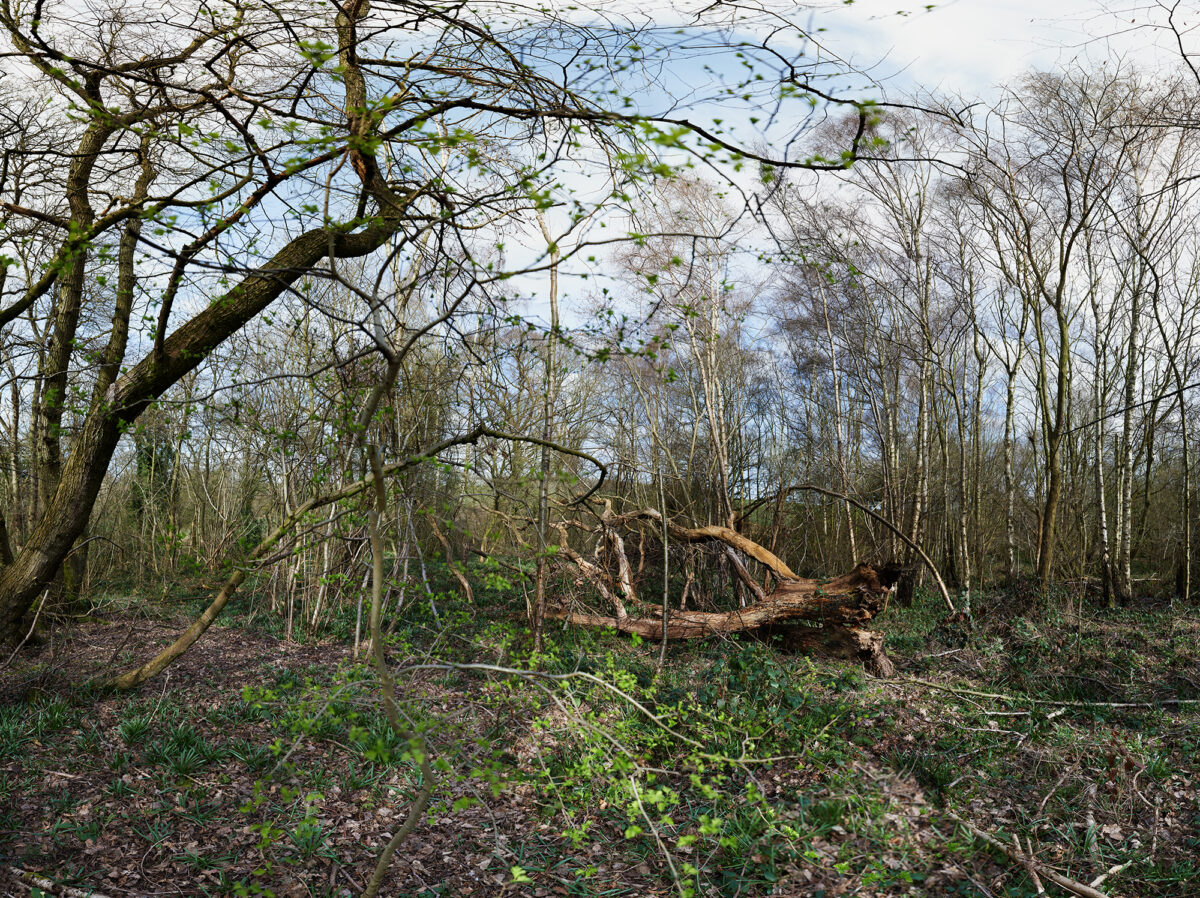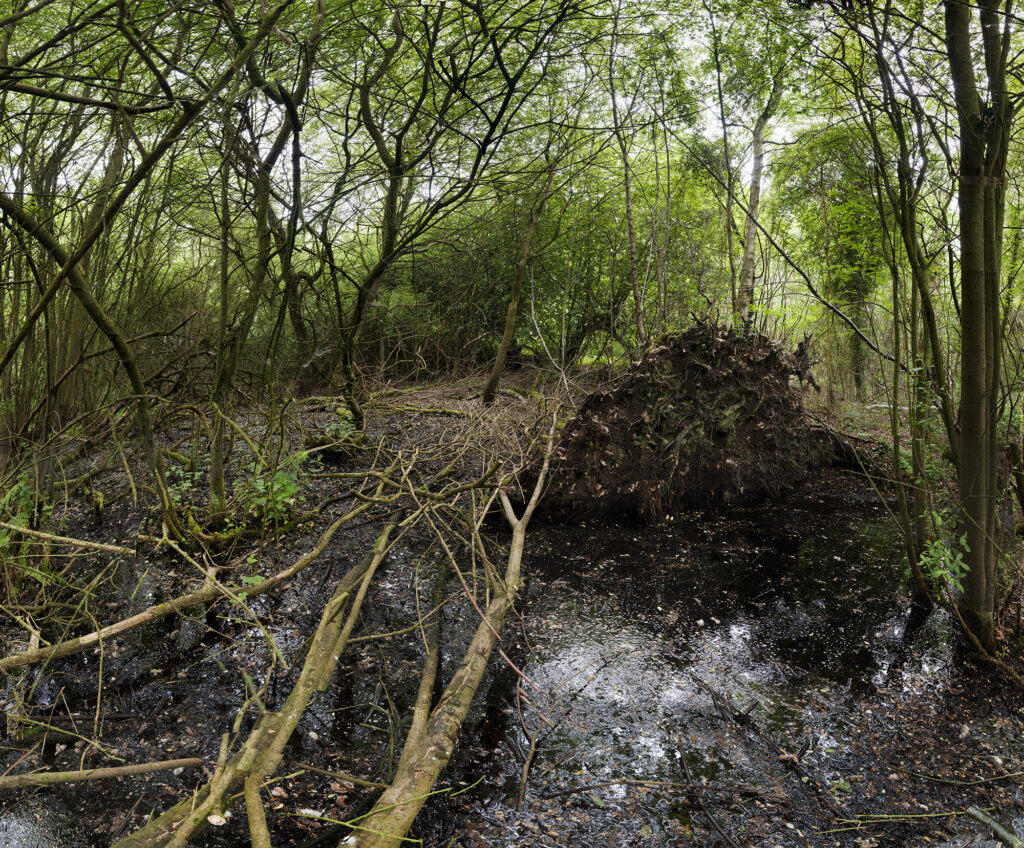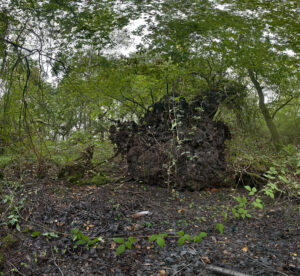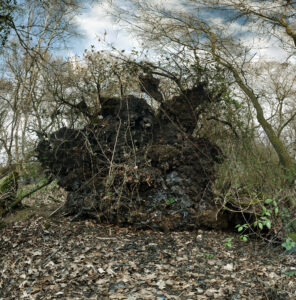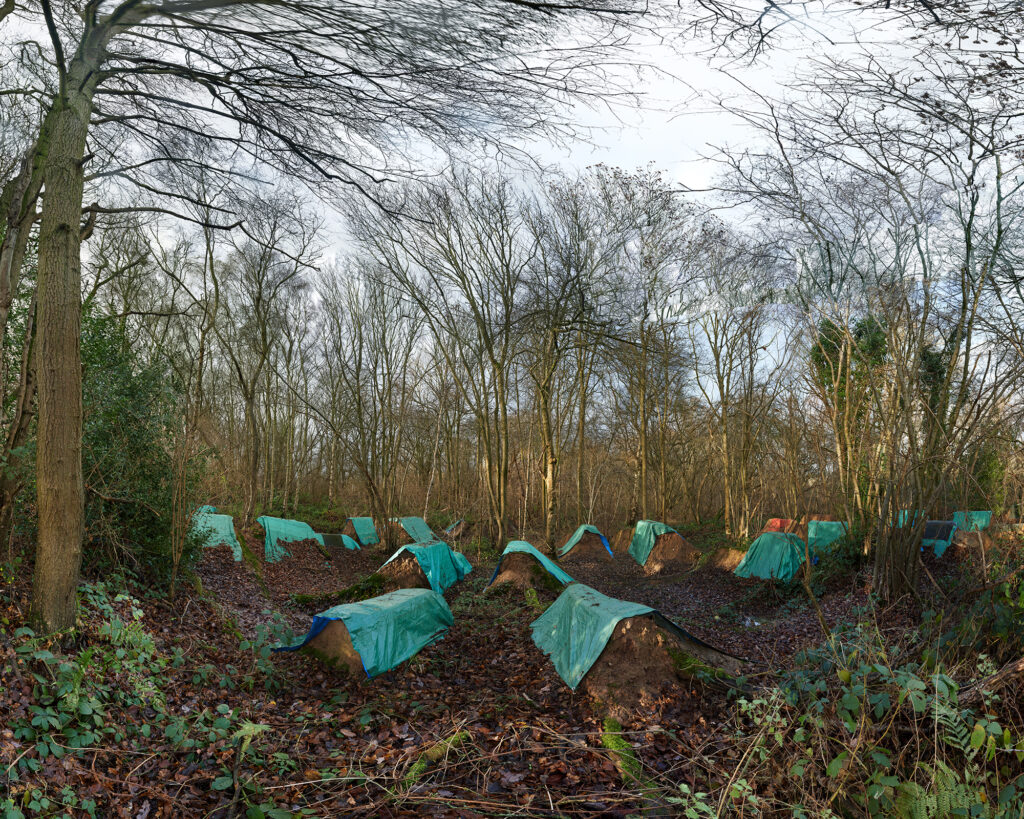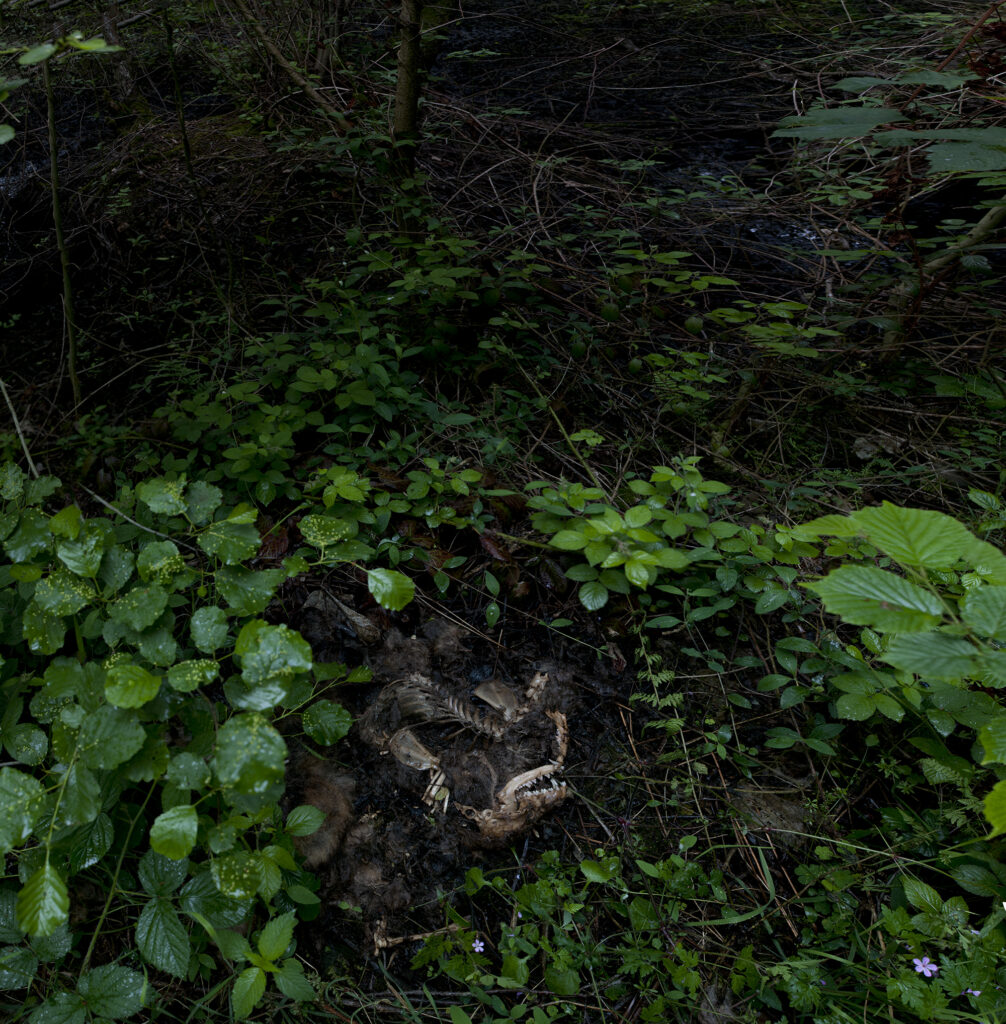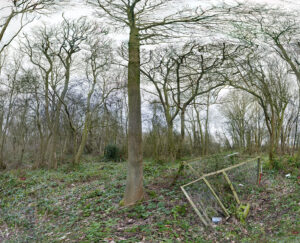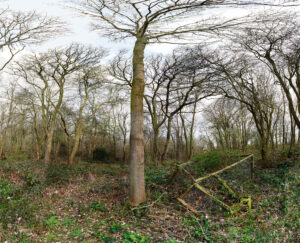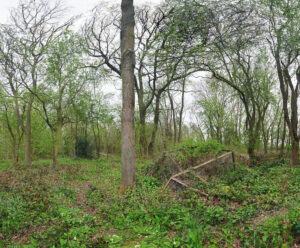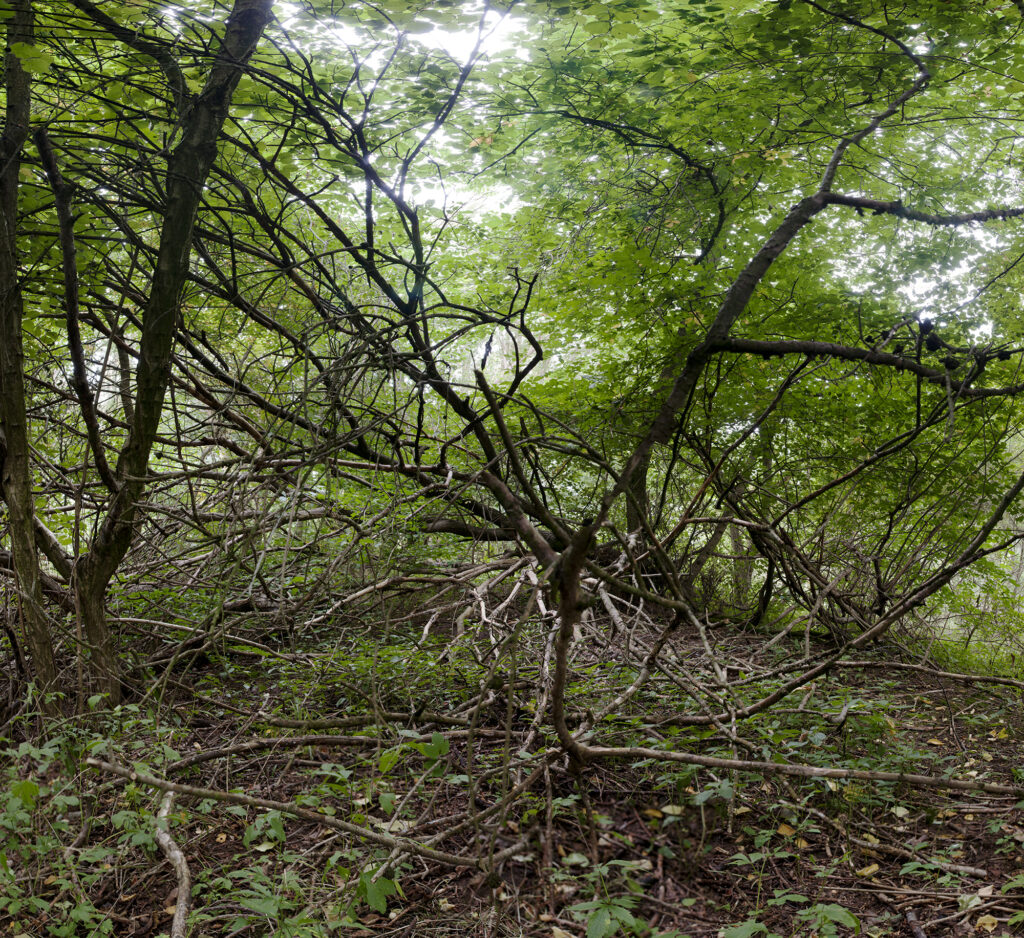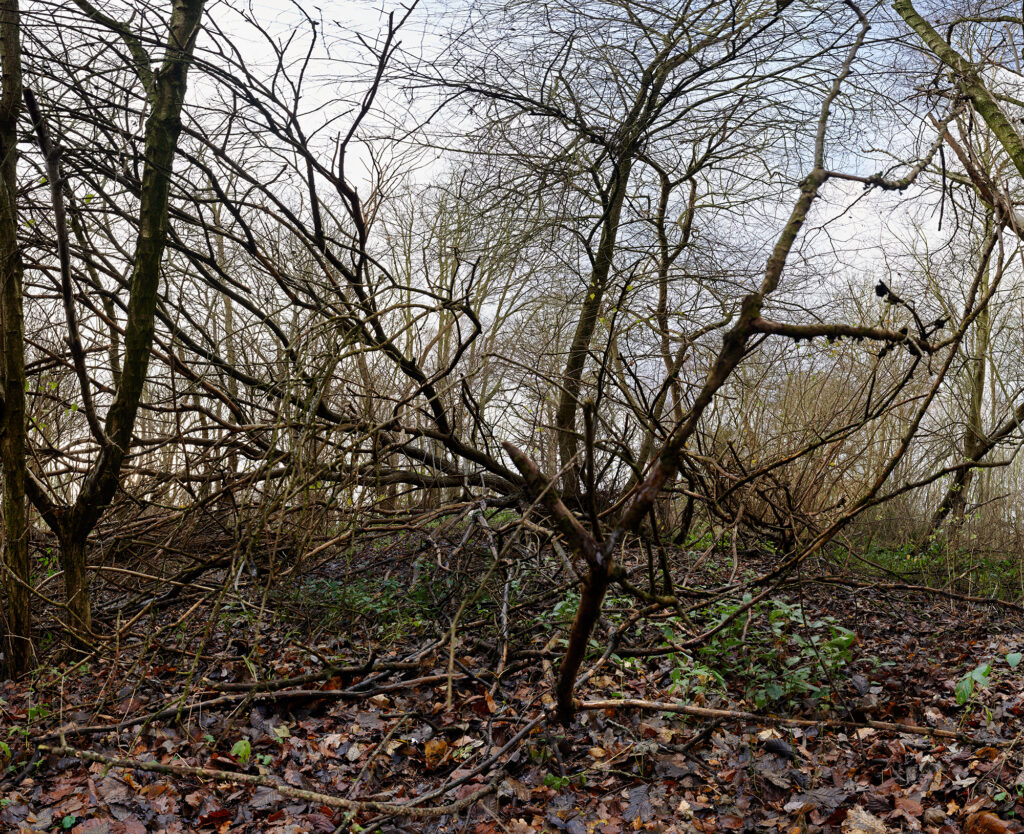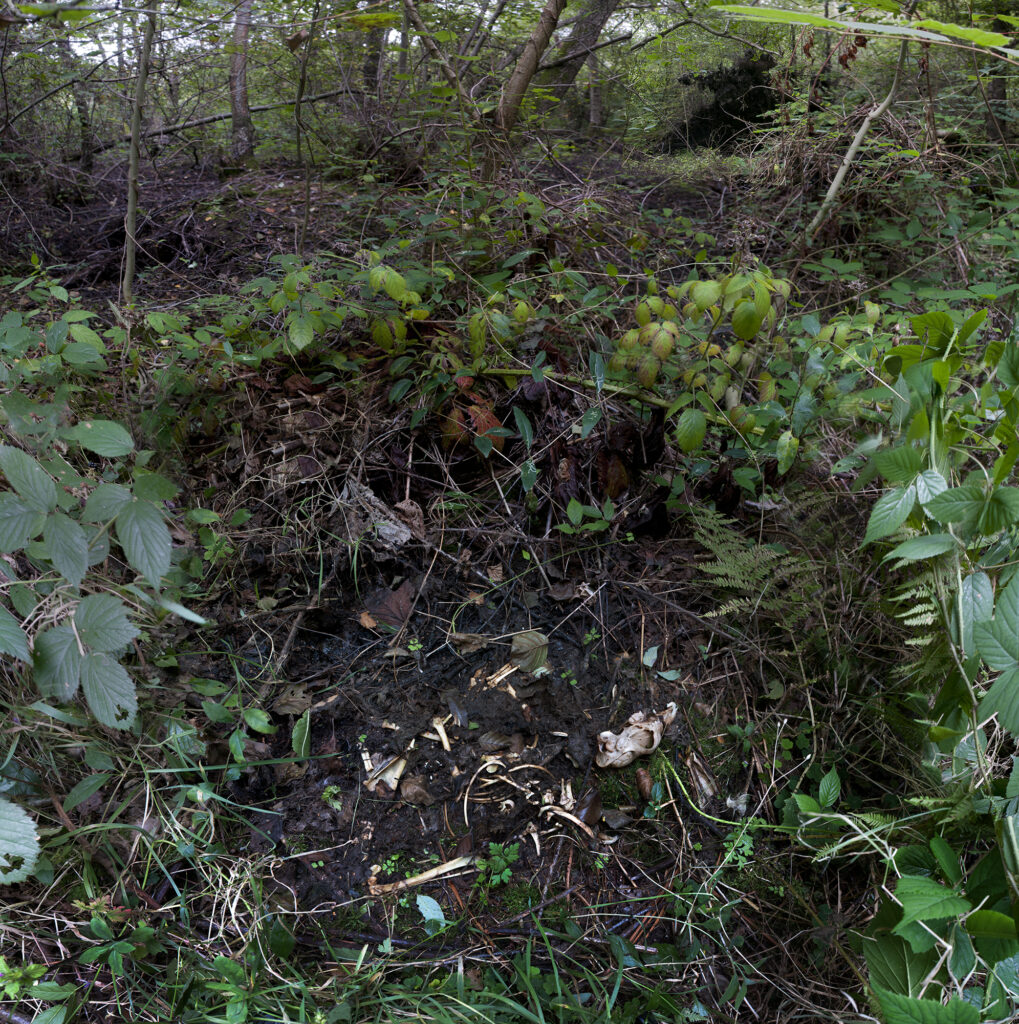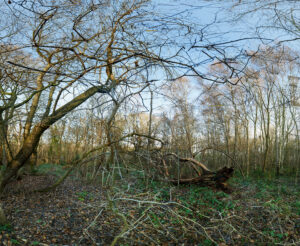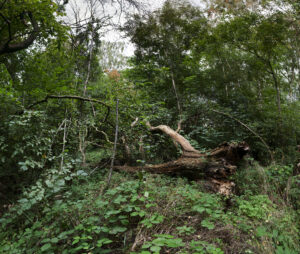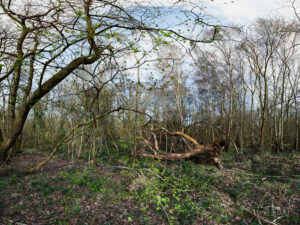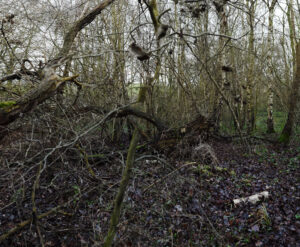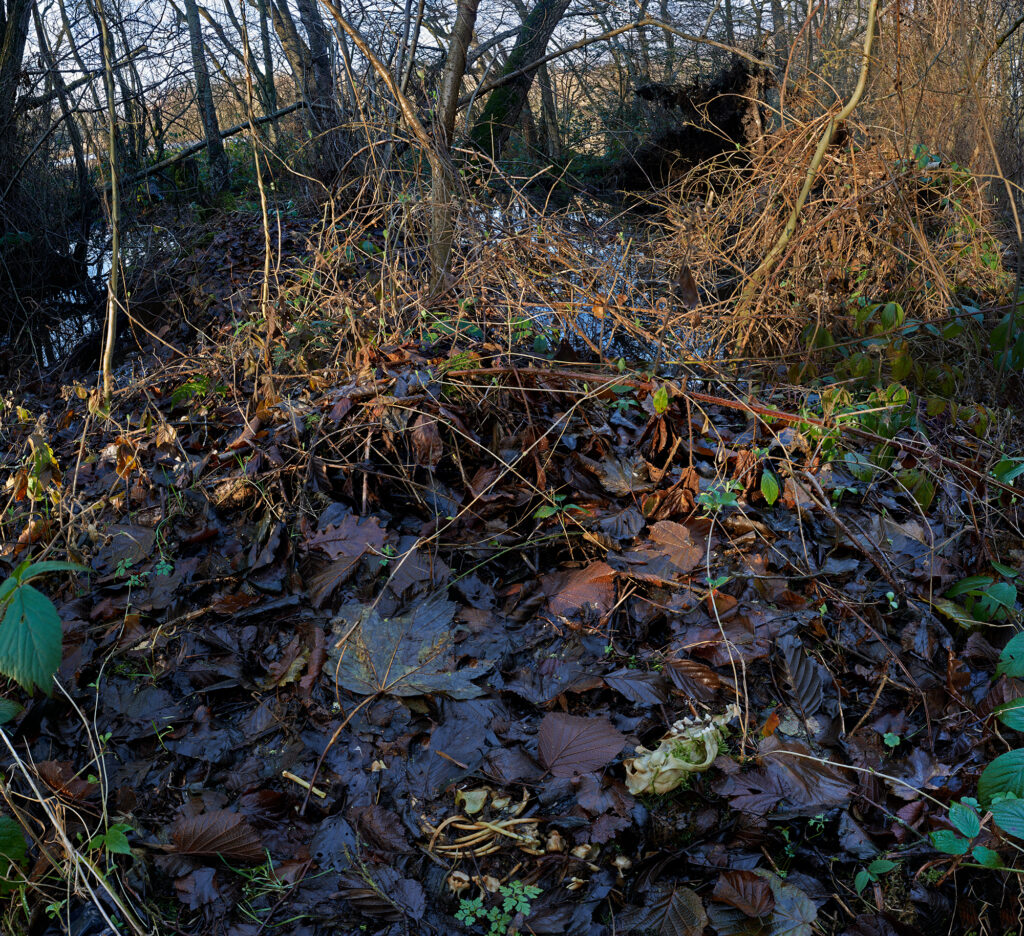Or
Notes From a Dead Fox
DE – DE – DE
DE – DE – DE
DE – DE – DE
• – • – •
(Like Morse code)
S – S – S
ON WOOD
=
Woodpecker
I venture out for the first time this year, late in January. Snow diminishes, water and temperature rise. Too hot in all my clothes walking to site, out, escaping into the light. Sunlight, occasionally, nearly, for the first time this month.
I wade through the flooded road halfway up to my wellington boots, ranging rods in hand and my bag on my back.
Fields are white, dripping. Slush and ice, water, mud, brown, black, white. I exile myself from indoors and the screen. Breathe, heat even Sweat.
Crunch of the soft compaction on the remaindered snow, off the road into the wet wood, green emerges, slowly, slow shoots show through mushed leaves, green on brown. Life awakens again defying gravity.
The ground is soft and flattened, the wood, though wet, is easy to move through. Without boots I would not venture, as I move the water is rising, snow diminishing.
I consider one tree-fall, near the mere, I’ve seen it before, never imaged it. Maybe on my way back – Perhaps I always think this here, keener to get to somewhere I am going, although I am not sure where that sums up to be. I intuit to a point of satisfaction. Far enough in to start. I intend only to make one work and return. Before and sometimes still I venture to push all effort beyond my limits of pleasantness. Sometimes fruitfully, but not on this occasion.
Time compacts again as I see the way to where I was last time I was here, flashes of memory and remembered images. Memories embody movement and effort as well as vision. The trigger is the way up that I came down. I could meet myself here.
I turn deeper into the marshy woodland, off human paths to the fox and badger trail – no human prints here. The trail is obstructed only above the height of the mammals that nocturnally traverse them. They all know I’ve been here, smell my scent and manufactured belongings.
Considering, looking, moving, stopping, listening
DE – DE – DE
DE – DE – DE
A rustle above, the squirrels are still in the ivy here. The camera is still on my back. The drips enhance my spatial awareness loud and quiet to imperceptible. Near drops loud.
Familiar scenes are passed on. Then I know. I’ve been here before and suddenly it all fits. Another tree-fall, out in the water. Instantly, nearly, perhaps, I simultaneously see the element and remember the image I made here last, subtracting all the other potentials and the environment to inhabit this space. One I have constructed before. I relate much quicker, less to take in, revel and revealing change.
The water is higher (and rising) frozen ice breaks as I immerse my foot, halfway up the boot. I move in and think, not the same position as before. Initially I think it is too hard to get to, the water too deep. Potential of cold not heat now. I move back to the bank put down my bag and the rods. Take off my coat (will it rain?).
Decide to pause ǁ
I place the ranging rod near the tree-bowl, not like before.
Tree-fall # 5 visit # 2
Out into the water. Why is the best position often mediated by my overall approach (physical not conceptual)? I decide the position I reach in the water, close to my initial look is the one. Difference is good. This is not the same place as it was last time I was here, so I need to emphasise this in my work. I push the extended tripod down into the mud below the ice and water, and work. Difference is what I hope for, with inevitably recognisable similarity. I vary my position as my feet get colder. Three pairs of socks are nearly not enough. At the end I remove the camera from the tripod and shoot around me to the edges of my composite environment hoping that more kind errors will occur in processing.
It’s done, unlike the canine bones image (A Deer in the Wood, it was a deer not a dog) I do not have a transformative experience whilst in the process of making, rather this began when I entered my own comfortable space here. The reciprocal place I know much better than the bones site (I guess I’ll never go there again).
Hunger makes me desire leaving.
I move back to the trail home. Finally I do stop and photograph the tree-fall near the mere, but badly – satisfied I have done enough today.
The fields have turned green as I exit the woods still patched by white and brown. I struggle through the flood using the ranging rods to look for shallow ground slowly moving on tiptoe, so as not to allow the wave, so near the top of my boots, from washing over. Ahead three dogs, Jess, Kasha and Granville wag in anticipation and my partner wishes she had her camera. Still waters rising, but I made it without spilling down inside my boots.
Extract from Field Notes January 2013
Tree-fall # 5 visit # 1, the image made on my first visit to this tree-fall.
One day, whilst working on Continuum, I was looking for some literary fiction in my local library when I came across Fyodor Dostoyevsky’s short novel Notes From a Dead House (1848). When I picked it up and borrowed it I had misread the title as Notes From a Dead Horse and this is what initially interested me. It wasn’t until I got home that I realised my mistake. In this book Dostoyevsky fictionalises his account of his experience as a political prisoner in a gulag in 19th century Russia. As well as being a inciteful study of human nature under confinement, the text also describes a limited space of living, of inhabitation. This notion, of a confined territory as a lived-in space, is one of the driving forces of this body of work.
On one of my fieldwork visits I came across a recently dead fox. This territory is my educated guess of the bounds of this fox’s territory, centred on Shomere in Shropshire, England. Shomere is an isolated peat bog and woodland beside a lake, surrounded by quarries and intensely farmed arable land. It is a pocket of managed wildness in an over-exploited landscape. A territory inhabited by badgers, birds, newts, frogs and foxes, amongst others, hence the subtitle Notes from a Dead Fox.
I have visited Shomere and its surroundings since my childhood, when I dabbled in fishing with my father and his friend Mal. My family home is now a couple of kilometres from the site and I have walked dogs there over the last twenty-five years. I practiced here between 2011 and 2016, following the variations in the landscape by repeatedly walking around the territory and photographing scenes undergoing change, making fieldnotes as I visit.
A Fox, I thought encounter # 1
I awoke in an odd mood that persisted through the day. After writing all morning I headed out to re-visit the pheasant cage.
Grey skies and wind, thankfully no rain. I slipped on the mud across the moto-x track on my way to the site, using the ranging rods like walking poles to balance. The woods are open, the foliage sparse in comparison to the last time I was here. Plastic stuck in a tree fluttered annoyingly as I worked. The pheasant cage had collapsed since the last time. I headed off in a different direction toward the blue tarpaulin site – deciding to avoid any tree-falls. Blue land had nothing to offer. I’ve done the best here, move on easily through flattened vegetation. On my way out I came across a corpse, bones and black feathers. I continued down the hill skirting around the edge of the wood this time , still in amongst the leaves. Aside from the corpse, nothing grabbed my attention.
Gunshot in the distance, on the other side of Shomere. Makes me wary – danger in my movements of being mistaken for prey, makes me extra vigilant, less confident or comfortable here, edgy, just as I have been all day, but heightened now. Light is fading but I continue on looking for more possibilities.
A fresh cartridge and a scatter of pigeon feathers, another scatter of feathers, no corpse. I cross the edge of the flooded wood, the water-ground edge as it is now.
Stillness. No wind.
I give up and move back to the path out of the wood. Dark skies as I walk glad to be on the way and I nearly miss the fox, lying on the side of the track. Dead. Small, unmarked, there for a short time.
Extract from Field Notes February 2013
Tree-fall # 1
Visit # 3
Visit # 1
Visit # 2
Shomere is a site of special scientific interest, or SSSI, as designated by Natural England, due to the presence of rare insect species and as a peat bog, or mosse. The site is therefore being managed for wildlife conservation. Part of this includes restoring the bog and in 2010 trees were felled on the bog itself and drainage channels blocked to encourage regeneration. The resulting increase in the water table has the result of undermining the remaining trees at the edges of the bog some of which have fallen in the increasingly common storms in the region. This is not necessarily detrimental to the health of the site, as the bog will regenerate better without trees constantly draining it and there are more woodlands on higher ground providing habitats for other species. These tree-falls interested me at first in relation to the traces of trees found on archaeological excavations. Tree-bowls are all that remain of trees, a differentiation in soils that when excavated have one sharp edge, on the side that the roots of the tree lifted from when it fell, and an indistinct other side, where the roots remained in place. Occasionally on pre-historic sites finds such as flint tools and debitage (the flecks and remains from flint knapping) can be found in them, indicating that the fallen tree was used for shelter in the distant past.
Blue Land visit # 3
Blue Land visit # 4
As I arrived here a buzzard called announcing my presence and flew away from its perch in a tree. since then it is quiet and has clouded over. Might yet rain. Mosquitoes keep coming to me. Not as comfortable and the spots of rain are beginning.
Blackbirds are alarmed behind me chattering like scissors. Reversing excavators bleep in the distant quarry. Rain hits leaves around me increasing mosquito buzz again.
After a while here my mind settles down. I slow to watch. The temperature has dropped and the breeze increased with the spots of rain.
Buzzard is back and lands behind me in a tree to my left. Pheasants croak (for want of a better word). I cannot see the buzzard now still in the tree calling, but I’m sure it sees me. Should I stay in the rain?
The land looks lighter as the clouds darken. Sounds behind me (buzzard and blackbirds) vision in front, leaves also rustle.
Buzzard goes.
I’m getting cold and wet – I’ll go myself
Extract from Field Notes July 2012
A Fox, I thought Encounter # 2
In undertaking this project, my intention was to investigate how environments change and how this is understood by those experiencing it. This occurs through time; changes are perceived through processes of repetition, both of being at the site repeatedly and by undertaking similar actions. Hence the emphasis here is on the passage of time as manifest in experience, not as an instant, but as a durational continuum. In life, the individual occupies a mobile space, a constant environment that is moved through and although I am occasionally present at each place, I am mostly absent. The site and the scenes in it continue to exist in this time, and is known through memory recall, hence change is that which is recognised as different from what was experienced before. In order to reflect this in the artworks, I repeatedly made images of the same scene, in order to interpret how change is experienced with photography.
The Cage
Visit # 2
Visit # 5
Visit # 7
These works are not single images but made up of sometimes hundreds of single exposures that are then combined using the automated algorithms of digital software. The software works by comparing similar configurations of pixels across images and combining them on the overlap. Imperfections in this process were deliberately used to reflect on the passage of time and the nature of photography itself, as distinctly separate from visual perceptive experience. Other factors also changed in the landscape as I worked. Vegetation was blown in the wind or as the sun moved behind a cloud. All this created imperfections that are visible in the works when scrutinized intensely, indicating the compression of time into each single still image.
Rhizomatic
Visit # 3
Visit # 4
A Fox, I thought Encounter # 3
Tree-fall # 8
Visit # 4
Visit # 3
Visit # 5
Visit # 7
A Fox I thought Final encounter
Notes from a Dead Fox formed the central element to the solo exhibition Continuum at Avenue Gallery, Northampton University in the late autumn of 2014. It was part of the culmination of a Practice as research Doctorate titled In Flux; land, photography and temporality. Some of the works here were made after this exhibition.

